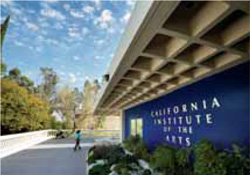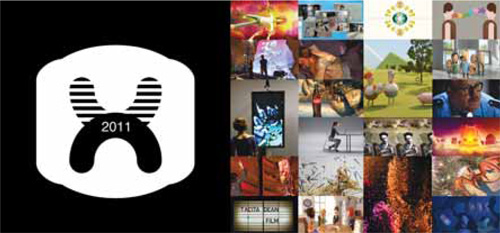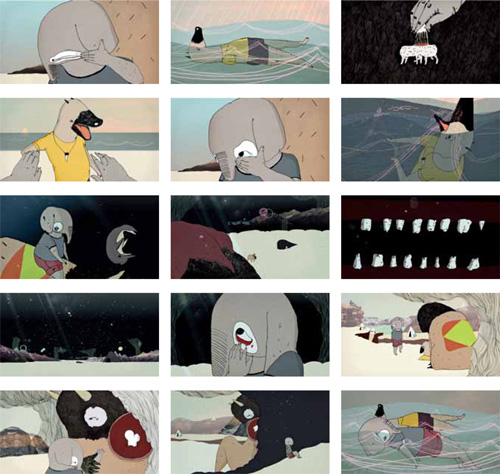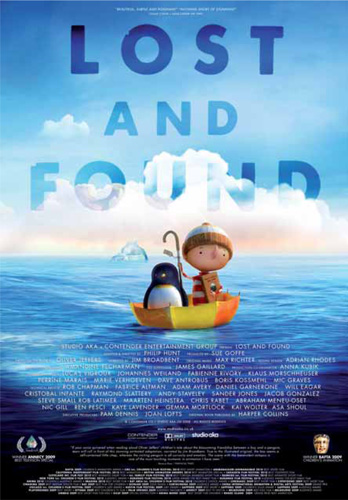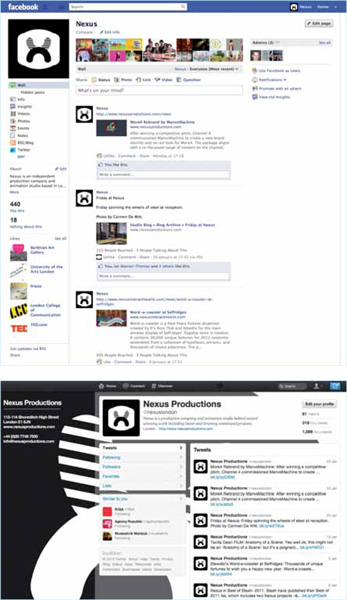This final chapter provides practical advice for those wanting to enter the exciting field of animation. As this book has illustrated, there are many different opportunities available. Whether you hope to work as an independent creator or as part of a global studio, on small-scale charity projects or full-length animated feature films, on a modest budget or a multimillion dollar contract, the journey will certainly be interesting and rewarding.
The chapter considers educational routes to acquiring knowledge and understanding of the discipline, outlines the core skills required by focusing on what potential employers are looking for, and examines some of the promotional choices available, including portfolios and showreels. Information is also provided on the benefits of gaining relevant knowledge and experience through placements and residencies, and on the places where job advertisements and opportunities might be found, as well as advice on preparing cover letters, application forms, and résumés and on performing in interviews. The chapter concludes with a brief overview of other forms of employment, such as freelance representation, and what you can expect from your new position.
The much-respected California Institute of the Arts attracts excellent would-be animators from all over the world and has an impressive list of alumni.
Education, knowledge, and understanding
In a world where more people appear to be “qualified” than there are job opportunities, one might cynically ask, “What is the point of doing a degree?” It is certainly true that a degree is not required for employment in the animation industry, and many people are employed globally without any formal art training. This merely illustrates, however, the massive developing opportunity of the medium, as witnessed by any visit to an animation festival, where the audience will routinely be made up of scientists, architects, artists, computer programmers, developers, and investors, drawn to the possibility of animation as a compelling communication tool.
So while formal education is not wholly necessary, anyone who wants to succeed in the animation field must possess knowledge and understanding. This can be achieved only through being prepared to educate yourself about the subject. Given the complexity of animation, the idea of signing up to a program of study that has done all the structural planning for you, has designed classes to explain the subject in varying degrees of detail, and which provides a supportive and creative environment to study in, suddenly becomes more appealing.
Established teaching environments have the added advantage of dedicated technical facilities populated by highly trained and experienced staff, and excellent resources and connections to networks that are influential and hard to penetrate independently. They are also able to demonstrate their success through current student projects and awards, and through long-established alumni who hold jobs in prestigious and inspiring places. And, of course, it is possible to continue your animation education to an extremely advanced academic, technical, or philosophical level, allowing your study journey to take you all over the world seeking the knowledge you desire. Without an educational framework, all of this planning, mapping, and resourcing falls on the shoulders of the individual, when all he or she wants to do is to create.

American animation phenomenon Don Hertzfeldt was the youngest filmmaker to receive the San Francisco International Film Festival’s Persistence of Vision Lifetime Achievement Award. He was thirty-three years old.
Students from all over the world enroll on the MA Animation program at the Royal College of Art in London every year, drawn by the many successful animation graduates to have made their names here.
Skills for future employment
Animation is a developing industry full of possibilities for students with a wide and varied skill set and an appetite to learn. Preparation for employment is vital and should be treated seriously. To demonstrate how focused and committed you are, taking time and effort to create the very best impression of yourself is fundamental to your future success. Critically, you will need to consider whether you want to be employed, or whether your future lies in controlling your own destiny by being self-employed. There are benefits and pitfalls to both approaches, and your decision will depend on your personal ambitions, core skills, and resilience, together with your ability to market and promote what you do.
Skills and attributes
As a general rule, you will need to present yourself positively to people who do not know you, so their first impressions of you are extremely important. In order to do this, you first need to understand what it is that you are offering. This can be difficult, as the idea of being objective about yourself is not altogether straightforward. In some cases, you may have to recognize your weaknesses before you can concentrate on your strengths. And you may have to answer difficult questions about whether any of those weaknesses can be addressed, and if so, how to go about this process convincingly.

Preparation, commitment, and focus—three core skills required to be a successful animator.
Understanding and evaluating yourself
If you find the process of being objective difficult, perhaps ask a critical friend or mentor to list your qualities and faults. Asking more than one person to do this helps depersonalize the results and can show trends, thereby being more reliable and informative.
Being honest about your strengths and weaknesses—even if the truth hurts—will help you to be more focused in promoting your skills and concealing your faults in your search for employment.
Learning how to take and respond to criticism positively and learning from experience is part of everyday life. Everyone has been through it— learn from others’ mistakes and acknowledge your own.
Take time to reflect on these soundings. Are they a fair and accurate interpretation of you and your career goals?
Summarize your experience and make an action plan that can help you address your findings by focusing your energy and resolve.
If the initial process of investigating your core abilities has revealed unexpected questions (or confirmed what you had already suspected), what are you going to do to answer them? Tenacity and ambitiousness are important qualities in every aspect of animation and by demonstrating that you have not given up at the first hurdle, you are already providing evidence to employers, partners, and collaborators of a desire to succeed.
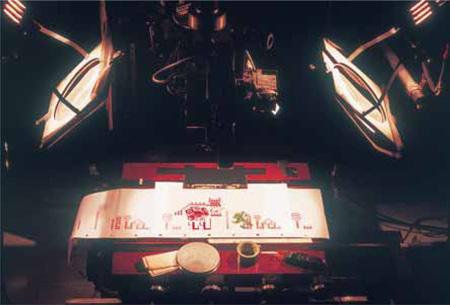
The dedication and commitment needed to study animation should not be underestimated, but the rewards are often very satisfying.
Answering your critics
If you need inspiration or more dedicated action to address your current weaknesses, consider one or more of the following as a way of positively helping to hurdle the obstacles to your success:
Research—finding innovative ways of investigating, understanding, recording, and analyzing subjects through concentrated periods of exploration and discovery should be at the heart of what you do as a way of questioning, interpreting, and authenticating your world.
Drawing classes—these are helpful in understanding not only classical anatomy and figurative form, but also nuances of the subject, such as the figure in the environment and, crucially, the body in movement. You will also see the way that others interpret the same subjects, as you develop your critical, technical, and aesthetic skills.
Writing classes—these are useful for meeting other writers and learning how to write scripts, develop characters, and create plot lines, subplots, and narratives that animation production is predicated on. Writing classes can also provide a critical environment in which to ask questions and be questioned, help provide excellent networking opportunities, and offer a supportive environment to learn, develop, and test your craft.
Concerts, performances, gigs, and recitals—regardless of what entertainment you prefer, go and see different performances, concerts, and so forth live. Watch how the performers engage with their audience and observe how the stage is set to allow maximum connection between them and the spectators. Live venues allow you to “feel” and “experience” the show by evoking all of your senses. Understanding this will help you to create better work, evoking similar feelings in your audience.
Animation events—again, move away from your comfort zone. Keep abreast of industry news by going to see directors and creators talk about their latest projects at festivals, film openings, and gallery events. Sign up to become a friend of places that promote animation and make a point of attending events, workshops, and activities so that you understand what is happening in the field you want to be part of.
Film clubs—get involved in local clubs and societies and meet fellow admirers and critics as you watch films, organize and participate in festival visits, and perhaps even arrange your own. Investing time, effort, and energy is a great way to interact socially with others, encouraging you to engage critically with the subject with like-minded people who will support, question, and challenge your point of view—usually on the same night.
Social media—seek out and follow inspiring talent online through sites such as Twitter, Facebook, or LinkedIn to find out what plans are afoot, how particular productions were created, and to establish where future opportunities might exist as they unfold. Being up to date and aware is important in animation since the subject, and the industry that supports it, is in constant flux.
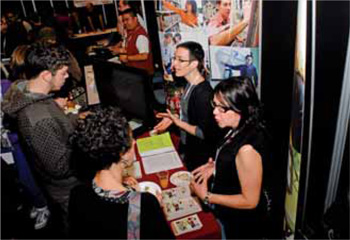
There is no better way of finding out what is new and exciting than by getting out and about on the festival circuit to actually talk to like-minded creators and enthusiasts about animation, as here at Ottawa.
What are employers looking for?
Given the variety of possible roles in animation, there is a range of core and transferable skills that are required to perform various functions. Some people possess very specific technical skills that are highly sought after, while others prefer to be more generalist in approach, enjoying the variety and diversity of their creative existence. Whether you are a specialist or a generalist, you can maximize your opportunities in a changing marketplace by keeping your skills up to scratch. Look to resources such as Animation World Network (www.awn.com) or Skillset (www.skillset.org) for information and advice to contextualize your requirements.
Employers invariably are looking for really talented people who are engaging and enthusiastic and who truly understand the medium. Demonstrating that you are a good communicator and a team player, and possess the flair and drive to work unsupervised to tight deadlines will be advantageous. It also helps to be able to have a good sense of humor, a calm disposition, and the ability both to see the bigger picture and to concentrate on the smaller details. Above all, be yourself. Being honest about your limitations suggests that you know your capabilities and hopefully you will get the chance to showcase them, allowing others to see where you can develop creatively, organizationally, and strategically, and flourish with support and guidance.
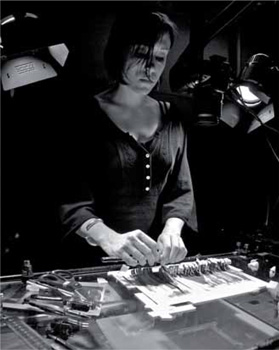
While a perception of animators is that they spend hours alone, employers look for a range of skills that often involve teamwork and shared responsibility.
Skills
General
Regardless of your projected “dream” animation job role, it is imperative to demonstrate a knowledge of and preferably expertise in the following skills:
Animation—the ability to be able to animate forms convincingly using the principles of animation to convey movement in visual form.
Observation—the art of seeing through looking, being able to recognize and record pertinent critical thoughts that connect with both the production team and the wider viewing audience.
Writing—the dexterity to communicate ideas, thoughts, and sequences convincingly with an awareness of different genres, styles, and expectations.
Professionalism—the ability to work to deadlines through self-motivated tasks or dedicated team working where appropriate to meet production challenges and schedules with an awareness for others in the wider process.
Communication—the ability to listen and talk, both within and outside a production, using appropriate language, protocols, and technology to talk to global markets, funders, supporters, and audiences.
Specific
By demonstrating an awareness of, and strengths in, the above general skills, it is possible to position yourself as a candidate for roles that require specific attributes and skills. As an illustration, the following roles are characterized by some or all of the listed skills:
Director—needs to have an overview of the entire production. He or she must possess good coordination and management skills in order to oversee the production crew, and must be able to make decisions about every aspect of the production and also to delegate tasks that require completion. Managing the schedule and budget also requires organizational, strategic, and detail-planning skills.
Researcher—must have an attention to detail, an inquisitive and inquiring mind, good organizational and communication skills, and an ability to edit out irrelevant material.
Scriptwriter—needs the creative skills to write the script and develop dialogue, story arcs, and sequential narrative for the production. He or she also needs to ensure that written material is originated, developed, and revised in tandem with the storyboard and previsualization of the work.
Storyboard artist—must be able to communicate through drawing and visualization, to think sequentially, and to apply acting and dramatic skills and interpret dialogue, sound, and special effects.
Animator—needs to demonstrate the ability to draw and visualize movement, interpret dialogue, sound, and special effects, and communicate effectively. He or she also needs to be patient.
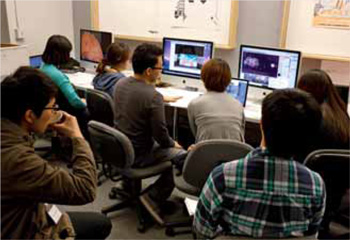
Students at California Institute of the Arts learn that the animation industry is varied, requiring a range of creatives with differing skill sets.
Promotion
There is no argument that the best industry professionals promote themselves intelligently, but there is plenty of discussion about how this can be achieved. In a competitive environment, the need to stand out is obvious, but the promotional approach is not quite so clear-cut. Time spent looking at what others have done is useful, but should also be set against quality advice from the people you actually want to see your work. This involves doing extensive research and analysis, through visits, events, and openings where animation is being screened and reviewed, as well as thoughtful, intelligent, and well-constructed questions directed to individuals and organizations earmarked as being able to provide you with insightful answers. Remembering that a base level of aesthetic, technical, and critical prowess is a given, what you will need to show when promoting yourself is that you have a personalized take on the subject that differentiates you from others in the field, and which invites inspection and scrutiny from those you are trying to impress.
London’s Studio AKA have won a commercial and critical following with their intelligent and witty productions that span short animated features, television advertising, and collateral projects where animated content is desired.
This level of expectation and rigor raises the obvious questions of how much promotion is required and what format that promotion should take. The quantity and quality of promotional material will largely depend on the kind of work that you want to do, your budget, the time you have available to promote yourself, and the level of engagement in the industry you expect to attain. It is very important for you to set the agenda in relation to your own promotional strategy, manage the content of your own marketing, and appraise whether your branding of yourself is fair, accurate, and inviting for the market you are selling to.
The whole promotional strategy must be consistent in terms of design, language, and sentiment. Any poorly researched marketing strategy will undermine the story about you. This in turn necessitates decisions concerning the promotional devices you will employ to tell your story effectively. Showreels, traditional portfolios, and supplementary paper-based promotion should certainly be explored as they are basic expectations, but you should also make efforts to research a digital presence in the form of websites, blogs, and social media.
What remains crucial is making the right statements about yourself, using the correct choice of promotional tool to illustrate a coherent story. Inevitably, that story will change as you progress, acknowledging skills that you have acquired, successes that you have achieved, and knowledge you have harnessed. Your promotional material must recognize and promote these developments effectively. It is, therefore, essential to recognize that different promotional materials have different lifespans. For example, a blog can be maintained chronologically like a diary, requiring continual feeding if you want your target market to consult it frequently. Printed cards advertising your latest production, however, have a longer shelf life, acting as a central focus to your advertising when the project is live or providing a useful back history of previous achievements as well as supporting material for future projects.
Promotional material must quickly hit the mark and provide an instantaneous insight into the work you create.
The following sections on promotional tools assume you have the right to publish material that is your own. However, any material that is not created by you, or has been created in collaboration with others, must be cleared for publication so as not to infringe copyright. Never assume that you have the right to publish, or you may be faced with a hefty legal bill. If in doubt, check with previous employers, collaborators, and clients, and credit their involvement where appropriate so that your work can be seen in this wider context.
The portfolio
The most necessary passport into the animation industry for anyone considering a visual role is the portfolio and showreel. These are the true showcases of your ability to demonstrate an understanding of animation as a form. It is imperative that the portfolio and showreel work together, emphasizing the message that you are a talent worth seeing and harnessing.
A strong portfolio provides you with a crucial tool to bridge the gap between training and employment. The work contained in the portfolio may explain your work better than you are able to do verbally, and can create a level of reassurance and confidence. Planning what to include, and where to position it, adds to the all-important story about you, and it is important, therefore, that the portfolio is frequently updated.
The portfolio provides reviewers with evidence of your skills in origination, development, and creative decision-making, and of the potential in your work. Consider having both a physical and virtual portfolio so that your work is showcased in static and moving form. Using a digital platform to show work is vital since moving images on screen can be effectively displayed and accessed on a website. Crucially, the portfolio can be laid out differently depending on your changing aims and objectives. Designing it to have a coherent and consistent visual style demonstrates that you are able to see your work as part of a bigger picture, which is appealing to employers wanting you to work as part of a team, especially in work for commissioned television series or feature films.
The portfolio must further showcase and project your skills and abilities, as anyone inviting you to show your work will have already searched for examples online. If your main area of interest lies in the development of characters, for example, then you should promote this by showing where your ideas come from, how the characters develop their significant and underlying characteristics, and how they are differentiated from one another. In this regard, you might consider supporting your portfolio with sketchbooks showing figure studies and the starting points from which you have developed characters, or by including sheets that demonstrate your understanding of anatomy, movement, and body rhythm.
Recent RCA graduate Julia Pott’s film Belly (2011) has been popular on the animation festival circuit, being selected for the Sundance International Film Festival 2012.
Animation relies on the development of ideas, so do not feel pressured to include only finished pieces. The portfolio need not be laid out chronologically, but it must illustrate how your working process allows you to develop your ideas sequentially. Briefly captioning material can be helpful if the portfolio is being looked at without the creator present. If you have material in the portfolio that has been produced as part of a partnership, ensure you have obtained permission from those concerned to show it to others. Above all, the portfolio must be easy to look at, quick to catch the viewer’s attention, and, perhaps most difficult of all, memorable.
The showreel
The showreel provides your main opportunity to reveal your ability to animate. Like the portfolio, the showreel should ideally focus on those core skills relevant to the nature of work you want to create, emphasizing them through carefully selected and edited material. Reels should be no more than five minutes in length and should show your most recent work first. It is generally accepted that not all reels are viewed in their entirety, so it is important to present your strongest work at the beginning and to consider your edits carefully so that they provide a coherent, punchy statement of intent about the kind of work you do and the ideas and skills you can bring to the employer. Crucially, the showreel should demonstrate that you have sensitivity to the way that subjects move, and this is often best achieved by including well-edited clips rather than full productions. Incorporating such elements as lip-synching or extreme moves is a good way to show the basic animation principles underpinning your work.
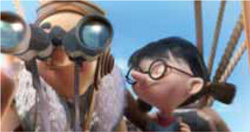
A portfolio should show your ability to animate with sensitivity for the subject matter being depicted.
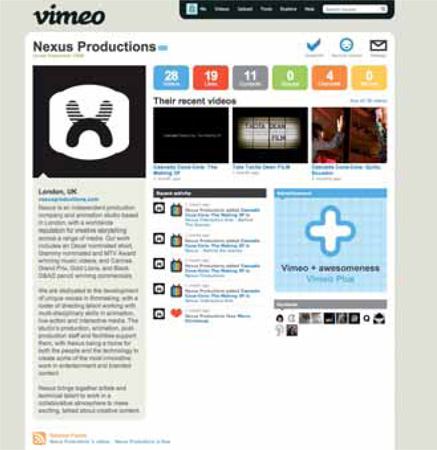
A showreel offers the chance to get an overview of animated work, presenting core technical skills with evidence of an ability to expressively interpret material through the synergy of sound and vision.
Again, a showreel may be physical, in which case it is usually supplied on a DVD (or on a format dictated by the studio), or embedded into your website, usually as a QuickTime movie or Windows player. The showreel should be attractively packaged, complete with a title, contact details, and a credits list. It is worth briefly explaining shots, techniques, and software applications used to help viewers understand what they are looking at and to provide a context of how and why different works have been created. This explanation also allows you the chance to distill some of your knowledge concerning shot selection, choice of camera positions, moves, and editing transitions.
When you come to output your showreel, make sure your playback settings are regionally compatible if you are intending to send it to international destinations, and be aware that certain subjects may be interpreted differently culturally than you had anticipated. You may need to consider editing several versions and adding subtitles if you are intent on working overseas. The showreel should be packaged sympathetically to resonate with any supporting documentation, such as flyers or posters.
Print-based promotion
The emergence of digital media does not necessarily mean that selfpromotion needs to be exclusively digital. Print media still has a strong resonance with some and allows a tangible opportunity to engage your audience through a medium that, depending on the materials used, relies on touch and smell, two sensory routes not embraced by digital technology. For example, screen printing your own promotional posters or flyers with oil-based inks will create both a tactile artifact and one that releases an aroma when it is unpacked. However, you can also be certain that anyone serious about the subject of animation will expect you to have at least some online presence, often because they will have familiarized themselves with you through an online search engine.
Many animators and writers try to maintain a portfolio of promotional devices. While there is no prescriptive formula, you might consider including paper letterheads, cards, envelopes, flyers, posters, small booklets (perhaps with interesting dimensions, folds, or printing effects such as foil stamping, embossing, or die-cutting), promotional toys and games as part of your promotional checklist. Some of this material will be designed to be sent out, but it is equally valuable to have cards, booklets, and flyers available to hand out at festivals and events, where recipients can make personal connections with you and place your work more effectively. Many festivals, galleries, and organizations are happy to accept printed matter to promote your work, provided that you have asked permission rather than assumed they will do your promotion on your behalf.
Promotional material comes in many sizes and forms, creating interesting opportunities to promote work to expectant audiences.
When designing any physical literature, it is essential to consider the recipients carefully. Receiving material through the post can be exciting, but it should be in a size and format that is friendly and non-obtrusive, otherwise the first impression is one of frustration and annoyance rather than delight. The choice of printing methods, sizes, and quantities is also important. Many prospective animators underestimate the cost of promotion, so you will need to work out what best fits your budget, resources, and ambition. Getting a professional printer involved with your promotional needs may not be as expensive as you think, can save time, and creates a professional, cohesive look. If your budget will not stretch that far, you might consider using a print cooperative where you can create your own promotional material, or one of the many online resources such as Blurb (www.blurb.com), Qoop (www.qoop.com), or MyPublisher (www.mypublisher.com) that offer a customizable set of templates leading to a range of professional, fully bound publications. These kinds of services are an economical way of creating a good impression, and the buyer can stipulate the scale of the print run, format, materials used, and a choice of bindings to present the publication ready for market. However, these services do require a sympathetic eye when designing in order to maintain your personal design direction and embrace your work ethos.
Websites
The Web is an immediate resource with many benefits for aspiring promoters. However, it is also one that should be treated with great care. The apparent attractiveness, versatility, and accessibility of the Internet must be measured against its security and volatility. While the site must promote your work, it is quite conceivable that it will also need to handle your daily productivity, as you use email, upload files, and generally go about your business.
It is worth spending time and money on choosing a service provider and Web host who can accommodate the kind of website you are intending to build, site, and maintain, especially if it will involve such functions as streaming video, which take up a great deal of bandwidth. Comparison sites are useful in enabling you to see providers, services, and charges in one place. Web space should be free of advertising and annoying pop-up banners, and should include the provision to host email accounts, online purchasing where necessary, and some form of FTP functionality that allows large data files to be sent and received. Inevitably, these services cost more as indirect revenue from advertising is not forthcoming, but the price is worth paying because they avoid any contradictory messages or unwanted statements, allowing the viewer freedom to look at your work.
Your website should have a clear hierarchy of design to reflect the visitor’s needs and should use simple navigational devices to help access the site. To achieve this, it is necessary to plan the site in detail and test out its structure on people whose opinions you trust. Some sites offer templates that can be used to create sites, such as www.weebly.com, but beware of keeping within corporate guidelines that do not best showcase your work.
Where possible, keep information simple, concise, and correct within a consistent designed framework that promotes continuity but does not impede the work.
• The home page should include your name, contact details, and a menu of information as simple, uncluttered headings that act as links to other pages.
• The home page must be well designed, inviting, and immediately understandable to the visitor. It should reassure them that this is a site of note and entice them to explore further.
• It is helpful to include a brief but relevant biographical history of yourself, citing meaningful examples of your experience to date.
• It may also be worth publishing testimonials, provided that they are seen as supportive and informative for the viewer.
• Choices about what work to show and how best to show it largely depend on the kind of work you create, but it is at least worth considering some images (and possibly brief descriptions) of work in progress as well as final film stills.
• Think carefully about where and how to embed moving-image components and consider the user in the process, as it is not certain they will have the same access to technology that you do.
• Make certain that the design works on different devices and Web browsers (Safari, Chrome, Firefox, etc.) and that the examples fairly and accurately reflect the work that you do.
• You will need to view the site on a smartphone to check whether your proposed design is compatible with this increasingly popular format.
• Good website navigational practice suggests that visitors should never find themselves more than three clicks away from the home page.
• The website should be built to a detailed schedule and should be reviewed regularly, especially checking spelling and grammar, as mistakes in basic language annoy users and send out a poor message concerning your attention to detail.
Once you have built your website, ask for critical guidance by placing it on a host server and making it initially available only to invited viewers. Importantly, listen and respond to the feedback you receive and make the necessary changes. Don’t become despondent by the comments, but instead accept that content or systems you have designed may not be perceived in the same way by someone using the site. A dysfunctional website, with broken links and inaccurate content, can seriously damage your reputation, so it is important to make any changes before you go live.
The emergence of social media has had a profound effect on the way that information is published, read, and digested. Online forums and the blogosphere provide scope to report and respond to posted information, encouraging increasing numbers of the public to review their consumption of news and information from traditional sources such as newspapers, magazines, and television. Blogs and forums have no length limitations, allowing correspondence to be archived and retrieved by both the writer and the user. Social networking sites, such as Facebook, allow individual users to create profiles to report news and events, or read the postings of others. They also allow common-interest user groups to be established, promoting information, awareness, and debate to a wide community of like-minded individuals, groups, and organizations. Most animation studios have their own Facebook page that they routinely update with news, job opportunities, and events. Microblogging sites, such as Twitter, offer further opportunities to instantaneously post news or feedback to stories or events globally. Their capacity to facilitate such immediacy is tempered by the limit to the number of characters that may be utilized.
The crucial thing to remember about social media is that their currency lies in the moment. Posting information is instantaneous, and it must be accurate and non-discriminatory. Your responsibility lies in ensuring that the information contained on any social media platform that you manage is professional, rigorous, and reflects well on you as a host. Ensure that your profile and information are well maintained and never share information that you do not want in the public domain. Posted information cannot be recalled and may cause irrevocable damage to you and your career. Maintain your sites and immediately remove or block posts that may in any way harm your chances of being perceived as professional. Guard against viruses and hacking attempts both by understanding privacy guidelines published by sites where you hold accounts, and by setting levels that tightly control what can and cannot be posted. If in doubt, seek advice from others first.
Gaining experience
Getting experience of the workplace is an excellent way to understand the nature and diversity of animation as a career path. Some college and educational programs offer opportunities to undertake visits and placements as a way of testing your skills in a real-life studio environment, while residencies may be granted by some larger organizations where space and funding permits. Studio visits organized in advance give students a chance to see the inner workings of a production, offering behind-the-scenes exposure to the working process, and allowing them the chance to meet and question employees about their roles on the project. Access may be restricted at busy times or where projects are in a sensitive state of development. If you are not enrolled on an education program, it is still possible to request a visit and some studios additionally have “open studio days” where the community is invited to see the work being done in its neighborhood.
Nexus Productions use social media such as Facebook to showcase the latest work from their directors, and link themselves creatively to other organizations to create an online community that permits greater exposure.
For those with more time available, placements (sometimes known as “internships”) are worth considering as a prolonged foray into life in the animation industry. Placements may last for days or weeks at a time, and can be paid, unpaid, or “expenses only,” depending on the size of the studio, the duration of the placement, and the location. Some college programs offer placement opportunities with established studios, while others are content for their students to forge their own career paths and promote themselves externally. It is worth asking admissions officers about this route of study in advance as this may help determine which program is right for you.
Securing placements requires good communication and diplomacy skills, and you will need to agree terms, such as the duration of your stay, the work you will be undertaking, any fees that you may earn, and whether the work you do is subject to any legal restrictions concerning your right to promote it. It is important to negotiate these details before commencing the placement to avoid misunderstandings and difficulties occurring. Currently, the whole issue of placements is undergoing scrutiny with regard to employment rights. It is worth checking in your intended country of placement what employment rights surround temporary placements. For longer periods of study, residencies provide an opportunity for intensive work and immersion into a subject. A residency might occur through an organization inviting an artist to work in the studio, encouraging shared creative practice and mutual inspiration for resident and employees alike. Residencies are usually offered through particular invites, will last for weeks or months, and usually involve payment. It is also worth noting that a different kind of experience can be achieved for those already employed in the industry through a paid or unpaid sabbatical. Organizations that offer residencies usually ask for examples of work from invited participants, or through a “competitive” process. Animate! Projects, based in the United Kingdom, are an excellent example of an organization that promotes thoughtful, intelligent residencies as a way of illustrating the diversity and ingenuity of the talent in the field.

Working in a studio environment while at college is a very useful way of understanding the intricacies of a career as an animator.

The perils of the wider world face all students of animation, but it is important to remember that famous directors once started from scratch.
Opportunities, applications, and interviews
Job opportunities in animation tend to follow one of two paths, namely an advertised position or an opening becoming available. Some studios advertise that they are hiring for positions both within the studio itself and through trade publications, on their own studio website, or on linked sites or forums where they are likely to attract suitable applicants with the necessary skills and expertise. The Career Connections part of the Animation World Network site (www.awn.com) is an example of an online marketplace where studios can advertise positions and employees can upload résumés.
Applications for job interviews vary according to the role being advertised. In some instances, the job description will ask for a completed application form and will require you to register your interest so that the company can keep a record. On other occasions, applying for a job usually involves writing a cover letter and sending a résumé. Following the wider employment arena will help you identify opportunities, compare job titles and responsibilities across the sector, and give you helpful information about salaries and benefits.
Job advertisements and opportunities
Some jobs emerge in-house as studios either take on more work or perhaps need to bolster their human resources to meet deadlines. Since these “spikes” in productivity may be temporary, most studios are reluctant to employ staff on a permanent basis, and will look to an accomplished freelance pool of talent instead to buy in the skills they require to complete the production. Some animators make a career choice to follow this path as it can provide higher fees and a more flexible working life, but they must also contend with periods of unemployment and limitations on where they can locate themselves in order to be close to studios. Where openings become available, staff working in the studio as “runners” or on low grades will be in a good position to benefit, as studio staff will have worked with them and built up an opinion of their capabilities.
When seeking employment, it is important to survey the market rather than jumping at the first advertisement, as you will need to show reasoned judgment about why the particular role is right for you. This means researching into the studio or organization that is advertising and investigating its history, current work, and projected future output. Your contacts and knowledge should help you be objective about your findings. It is also worth considering whether an advertised job fits your career profile, or whether strategically it would be better to wait until you have more experience before applying. It is quite acceptable to ask if you can speak to the advertisers for more information on any job role. Always be professional and courteous in your request and acknowledge any help you receive in developing your application.
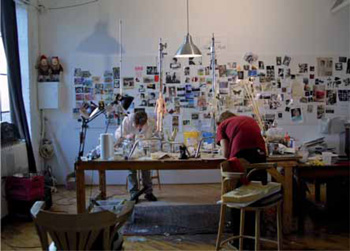
Employment in the animation industry is hugely varied, from major studios and production houses through to small independent creators, each offering opportunities for growth and development.
The application form
If you are required to complete an application form, you should have the job description to hand in order to match up the essential requirements for the role and to articulate these clearly. It is important to be concise and fluent in your responses, so take your time to read the application form before filling it in. Allow yourself enough time to complete the form, as you may need to check specific details, such as dates, levels of responsibility, or references. Always communicate in advance with the people you wish to use as references to validate your application, and choose people who know your work best for the role you are applying for.
Application forms provide the all-important introduction to you, and allow prospective interviewers to formulate interview questions that try to align your previous experience to their current and future requirements. Aim to include details that are relevant and specific to the role being advertised, and provide clear details of how you feel your skills and attributes match or exceed expectations. At the same time, you may wish to introduce facts in such a way as to necessitate specific follow-up interview questions, so balancing how much information to give with how much to keep back is a strategic move that requires planning.
The cover letter
In your personal absence, the cover letter becomes your representative and ambassador. Any document leaving you must provide a consistent and coherent story about you that is professional and articulate. A well-designed, thoughtfully written cover letter is often the passport to ensuring that your résumé gets read, and brings the offer of an interview a step closer. It is also one of those instances where having physically printed letterheads on specially chosen paper stock can be worth the investment, as the impression created by a professionally printed document is often subconscious but longlasting. Print-on-demand means that it is possible to use decent stationery to create the right impression at the same time as allowing for contact details to be updated without having redundant stock.
Again, thoroughly researching your recipient and attending to the details you find out is vital to ensuring your letter is well received. If you are looking for work speculatively it is worth bearing in mind that inquiries by post are more formal and less likely to be ignored than an email approach. You should make efforts to obtain your recipient’s name, job title, and correct address and include this in the letter. Briefly explain who you are and give relevant details of your background, qualifications, and interests, and demonstrate that you are aware of what the recipient and company has recently done. If you are writing formally to answer an advertisement, you should additionally state your availability to answer questions or to informally introduce yourself in person. Spellcheck and proofread your cover letter, correcting any mistakes and ensuring that your contact details are correct. Make sure you keep a copy of the letter and log when it was posted. It is best to allow a period of seven to ten days before making any follow-up approaches. These can be conducted through email or telephone, again being respectful and concise in your manner of inquiry.
The résumé
The résumé, or curriculum vitae (CV), is intended to provide an overview by briefly introducing you, illustrating your experience, skills, and qualifications, and summarizing your recent achievements. It should provide a complete body of information for potential employers so that they can ascertain your suitability for a particular role. For animation positions, the résumé will usually accompany the showreel and portfolio. If this is the case, allow those visual devices to show your ability and try not to replicate this information in the résumé, but perhaps describe or denote the work in a descriptive summary that provides a wider context for those viewing your material.
Taking a design lead from the cover letter, the résumé should provide information in the order that you want the recipient to read about you and should expressly address the position being applied for. The résumé should never be more than two sides in length so, when constructing the document, you will need to bear in mind that it will be reviewed by people wanting to extract information from it. Therefore, keep your résumé factual rather than overly conversational.
The basic requirements for a résumé are that it contains your name and contact details, together with well-defined sections detailing your qualifications, experience, skills, and achievements, concluding with details of references. Provide your full contact details and make certain that these are permanent numbers and addresses wherever possible. State your nationality and whether you have relevant rights to work in the country to which you are applying. Information should be given chronologically, indicating your most recent relevant qualifications and experience first. Be explicit about the work you did for each job or production, as this will allow the reader to focus on your skills. You should also include any skills accreditations, listing the most recently acquired first, as this promotes the idea that you are continually improving your skills.
Make sure the language used in the résumé is representative of your personality, as striking the right tone is important and, again, shows you have researched the recipient. Spellcheck and proofread the information carefully and consider asking a trusted, but critical, friend to do this as well. Always ask your intended references for permission to list them and provide their correct job titles and contact details. Finally, review the information on the résumé to check it is focused and applicable to an advertised post before sending the document.
The interview situation need not be a nightmare boardroom experience if you have prepared yourself correctly and believe in your own ability to make a positive difference to your potential employer.
The interview
If you are called for interview, it is important to be professional in your dialogue before the date, ensuring arrangements are made to suit both parties. Having a portfolio and showreel to hand is a real advantage if you are nervous. Remember that the people interviewing you have invariably been in your situation themselves and so will take any anxiety into account. Additionally, they will have a view on you already as your application, résumé and showreel will have preceded your arrival, and they may have sought references.
Preparation is the key to a successful interview and the hard work should be done beforehand by researching the company, finding out about their history and current output, their competitors and ambitions, and by understanding how the role you have applied for can help contribute positively to these targets. Your preparation should make you more confident, so practice talking about your work, explaining your choices and decisions and making sure you are focused on the job in hand.
On the day of the interview, dress professionally but comfortably. Arrive in good time and introduce yourself clearly. Be friendly but professional at all times and maintain eye contact and exhibit positive body language with your interviewers.
Questions during the interview will center on your relevant previous experience, your qualities, strengths, and interests, and your ambitions for the future. Always try to answer questions clearly and concisely, by providing information that answers the question, rather than veering off at a tangent. If you are encouraged to elaborate on a particular answer, try to use a pertinent example to make your point, but again be mindful of the answers you have already given, and refrain from repeating examples as it suggests your experience is limited. In an interview situation, you should be prepared to ask questions of your interviewer, so it is worth configuring your previous research into a list of questions that you have not been able to find answers to. These might include opportunities for flexible working, appraisal opportunities, opportunities for career development, and team-building exercises. This demonstrates your personality and shows your suitability for the post or to be part of a creative team.
You may be required to provide evidence of your employability status, so it is worth taking some form of official documentation with you, such as a passport or driver’s license. Contrary to popular belief, it is not necessary to disclose your current salary. Instead, it is perfectly acceptable to answer that you are prepared to negotiate a mutually beneficial package. It is unlikely that a package will be discussed in an interview setting, but you must be prepared to be called back in once the interview is completed to discuss personal terms if you are successful.
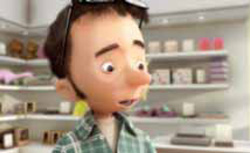
Avoid being put on the spot in an interview situation by doing your homework about the employer well in advance and absorbing the information so that you can answer questions truthfully and accurately.
Salary scales are sometimes available in larger organizations and these are useful in seeing your prospective employment threshold and projected earnings, but you should also consider other benefits in kind, such as pension arrangements, holiday, insurance, and healthcare cover, as these all contribute to the overall package. It is quite appropriate to ask for time to consider any offer that is made, and you will need to carefully weigh up the benefits in relation to the responsibilities of the position. Consult with legal representatives, employment agencies, teachers, friends, and confidants if it will help you arrive at a measured and informed decision. Accepting a position can be done by phone or email, but must be followed up with a letter of acceptance. Declining a position should also be done via letter, remaining polite, courteous, and professional throughout.
Representation
Some animators, voice-over artists, and directors who choose to work in a freelance capacity opt to be represented on agency sites. For an annual fee, the agency and creator agree representation terms and work together to satisfy the creative and commercial needs of the commissioning client. Such arrangements are attractive to freelancers as they promote their work to a wide audience professionally, contextualizing it against other professionals and providing an attractive and inviting shop window for viewing. The arrangement benefits the agency through the commission and advertising revenue received, the awards that might accrue with representing a stable of exciting artists, and the diversity and specificity of talent on offer for hire. Many agencies have branches or sister agencies throughout the world, allowing maximum exposure to a variety of clients and markets.
Most agencies operate on a contractual basis that is mutually negotiated and agreed between the agency and the creator. The contract covers the terms of representation, the percentage of commission and royalties that are charged, and the operational costs to the agency that will be charged to the artist. If your work is represented by an agency then it is likely you will be asked to contribute to advertising expenditure, marketing campaigns, and promotional costs that will benefit your work. Agencies should be open and transparent about the costs of representation and you should ask for their terms and conditions of service before signing any contract. In return, it is likely that they will demand exclusivity in representing you or, at the very least, an assurance that any promotion you do will not conflict or interfere with their publicity.
The commission rates of agencies can differ according to the kind of work commissioned, the method of broadcast, and the type of rights required. You should never sell your copyright to any works under any circumstances, and should agree to limited rights purchases only where you have gathered sufficient specialist legal advice. Selling any form of rights gives the buyer more control over how your work is used and viewed. Retaining and asserting your rights as the creator in a digital arena is hugely important, since any works created may have a completely different currency in years to come and may be sold several times over for different purposes. By retaining your rights, you have custody of those decisions that may benefit your work financially, professionally, and critically.
Some studios actively promote their directors as effectively “for hire” creatives for clients to pick and commission, and then produce the project in-house using the studio talent behind the scenes directed by the commissioned artist. Examples of such studios include Studio AKA, Ridley Scott Associates, and Tandem Films.
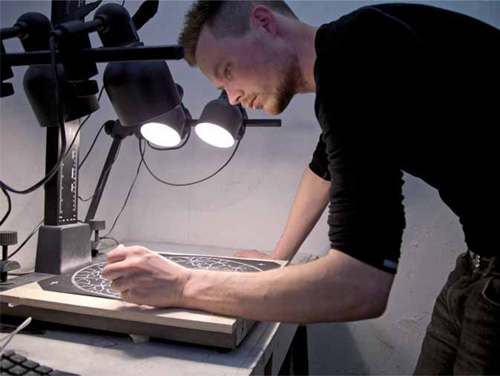
Animation draws a wide and varied crowd with a range of skills and expertise into an everdeveloping learning environment.
With your employment confirmed, now all that is left is to live up to your billing. Many organizations have introductory processes to help new employees become established, but it is not uncommon to have to demonstrate your skills quickly in a pressurized, challenging environment. If you have a period of time before commencing work, it may be helpful to meet your new production team in advance, perhaps for coffee or drinks after work, so that you become acquainted with the working dynamic on friendly and informal terms. Remember, these are the people you are going to work with, so first impressions count for a great deal.
If the studio gives you documentation to read prior to starting your period of employment, you should read it and absorb the information. It is likely that you will be working alongside others rather than in isolation, but being employed means accepting responsibility for tasks. Above all, enjoy it— it is supposed to be fun! Immerse yourself in your new world. Be committed, enthusiastic, and capable, accept others’ ideas, and offer some of your own in the spirit of professional teamwork and an ethos of collective ambition.
Conclusion
This book has chronicled the journey of an animated project through a notional production pipeline: from the origination of a concept to the collecting of research and developing the idea, from structuring the story to developing the images and sounds to a point where they can be manufactured and tested, produced and synthesized, then finally outputted, released, and distributed. That such a simple, linear process can have so many wonderful and astonishing variations is credit both to the versatility and possibility of a continually evolving medium, and to the intellect, expertise, and fascination of the people who call it their home. Animation needs new pioneers: those who can bring their talents, questions, and answers to the field, examining, challenging, and redefining the boundaries of the medium and thereby encouraging a whole new audience to become enthralled by the wonders of the form.

